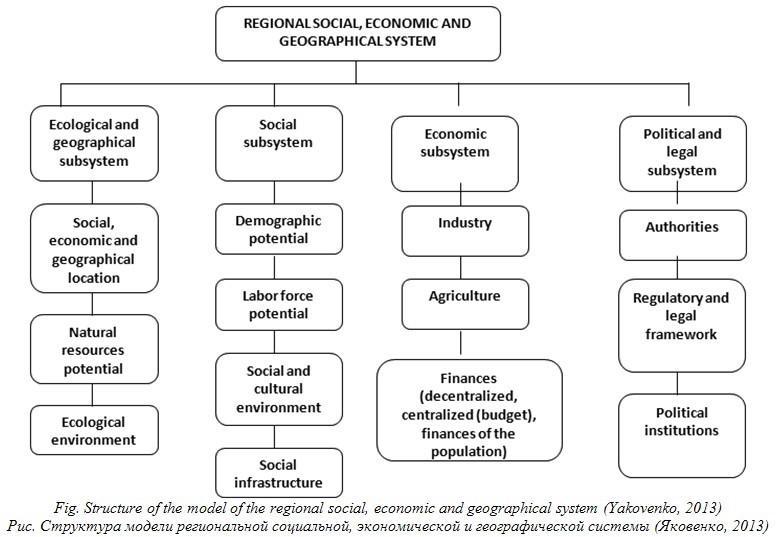РЕГИОНАЛЬНЫЕ СОЦИАЛЬНО-ЭКОНОМИКО-ГЕОГРАФИЧЕСКИЕ СИСТЕМЫ: ПОДХОДЫ К ОПРЕДЕЛЕНИЮ
Aннотация
Статья посвящена анализу теоретических подходов к определению понятия «регион» в работах отечественных и зарубежных исследователей. Исследования региона как социально-экономической системы представляются достаточно обычными в современной социально-экономической и географической науке, однако единый подход к теоретической оценке категории, ее определению и формированию ее подсистем до сих пор не существует. Регион считается сложным пространственным объединением интегральной системы, которая представлена местным территориальным комплексом взаимосвязанных социально-экономических подсистем, характеризуется определенной структурой производства, особенностями социальной инфраструктуры и людских ресурсов, принимая во внимание место и роль конкретного региона в социально-экономическом комплексе страны. Авторами делается акцент на топологическом подходе к определению понятия «региональная социально-экономическая и географическая система». Модель региональной социальной, экономической и географической системы актуальна для каждого субъекта федерального государства и разрабатывается с учетом особенностей и исследуемых характеристик. Таким образом, область обладает конституционно закрепленными компетенциями и полномочиями. Существует три уровня функциональных и структурных подсистем, которые проявляются на макро-, мезо- и микроуровнях. Уровни социальной, экономической и географической системы (сегментов) совпадают с существующей в России государственной структурой благодаря своей роли в формировании базы всех территориальных социально-экономических систем
К сожалению, текст статьи доступен только на Английском
Introduction. Economic and social geography is an integral part of the system of geographic and social sciences. Within economic sphere, its studying objects include social, ecological, political, psychological and religious aspects of the human society development process. This direction of geographic science integrate social and economic sides of the human being into the united whole. The branch is also called «social and economic geography» and «social geography». In spite of the fact, that it is a new direction, the social and economic geography possesses clear constructive purposefulness, comprising more spheres than forecasting and problems analyses. Integrity and complexity make the science an integral part of geographic education as well as of forming geographic mentality in XXI century. Last decades set up numerous problems and challenges in the fundamental base. The subject of economic and social geography – the territorial organization of society − spontaneously becomes more complicated, its architectonical structure and dominant evolution factors transform. All this signifies a strong necessity to adopt former concepts as well as to develop new approaches, theories and methodical tools for further research in this sphere. The key initial theoretical base for each science turns to be the necessity to reveal the subject of research and its structure. Contemporary, detailed research of composition and structure turns to be a milestone for scientific research in general fundamental sciences. Conventionally there are three approaches towards definition of the essence of the concept «region». It may be said, that each approach is aimed at realization of different aspects in regional economic studies. All existing points of view not only exclude but mutually complete each other.
Literature review. The concept «region», generally considered as a part o global space, is used by many regional social sciences, which studies political, economic and social space. Thus, the content of the definition depends on a methodical base of research. The system approach in this case seems to be effective. It allows to make a behavioral model of the subject, to reveal factors and regularities in its development and all in all, to forecast possible future events and influence on changes in a favorable way. It is considered that the founder of the system approach is L. von Bertalanfy, whose first work with the concept «system» appears in 1940 [12], an article about the necessity and ways of formation for general theory system in 1949 [14], work with affirmation of the fact that coming into being of the general theory of systems is a fact in 1962 [13]. Thus, we could take as an example the definition given by M. Gunnarsson. In his point of view, region represents interaction of «actors» and institutions in the framework of the geographic theory [6]. In contradistinction, a well-known political analyst − an international relations expert K. Deutsch offers another so called «summative» definition for the concept «region», considering it as group of countries, which are closely interconnected according to some parameters [2]. There is also a relatively solid approach, represented by E. Markusen. In her interpretation, «region» is a historically evolutioning territorially compact community, which contains physical surrounding, social and economic, political and cultural environment and spatial structure different from other regions and territorial unities such as a city or a nation [17]. Thus E. Markusen is the first insider, who put attention on interconnection of the meaning of region, nation and city and mark out from all this diversity of the concept «region». Efforts to define region within typical criteria were also taken by one more scientist − М. Russet. He considers the following explanatory definitions to make the question precise:
- regions are homogeneous in social and cultural aspects; states of both regions stick to the same position towards inner attributes;
- the region is formed by the states with similar political attitudes; the states have a common view over world tendencies and similar behavior on the world arena, which is possible to reveal during votes in the un.
- politically interdependent regions, connected via systems of national and intergovernmental political structures;
- economically interdependent regions, connected by close interregional trade with the volume that could be defined by proportions of national income, etc. [3, 5, 8, 10, 11, 15, 16, 18].
What is more the concept international political region, which is used in political sciences, is operationally updated. Contemporary there are many approaches towards regions classification: geographical, political, ecological, informational, civilizational, etc. Generally insiders divide regions into two big groups: homogeneous and functional regions. There are three subtypes of homogeneous regions:
- natural regions, which outlines are defined by common topographic, climate and other natural characteristics (nordic region);
- regions with the strong sign of common cultural and historical identity (Scandinavia);
- economically self-reliant regions with a common type of industrial productivity (Big Volga);
- elements of the functional region originally not necessarily similar. Creation of such regions supposes some interaction and integration inside which is a crucial aspect to provide complementarity of all aggregating territorial elements. Noralv Veggeland with the use of functional approach divides regions on functional, cultural and administrative.
A functional region could be characterized by a narrow and specific interaction aim, the region is concentrated on some benefits within the frame of the particular sector via regional cooperation. These could be, for instance, some trade aspects, custom policy, educational sphere and integration. The cultural type of the region is based on the questions concerning identification issues. Homogeneity within the particular territory is formed by common legacy, language, traditions, etc. Thus, the «cultural» region differs from other territories. Activities within one region could vary with a wide specter of matters. The central issue for the cultural region is its functioning «down-up». n. Veggeland concludes, that cultural regions could form a foundation for the development of functional regions. An administrative type of regions refers to the administrative structure which exists in states with hierarchal structure between municipalities, districts and central administration. From this point of view, a district, for instance, could be referred to the region.
Results and discussion. Within social and economic geography, economic and geographical definition appears to be the base for regionalization, to mark out of territorial systems and formation of territorial and industrial complexes. The administrative approach is closely connected with modeling researches (carried out on the ground of the economical and geographical approach) over regional configurations of different scale. However, the reproduction approach is instructive to develop the regional economic policy and selection of tools for its implementation, as it characterizes the region in the view of the national economy subsystem, as well as a relatively independent reproduction system. Consideration of the territorial entity simultaneously as a part and as a unity allows to define the scale of interference into regional development from the side of federal governing bodies and correlation of different tools of regional economic policy, which are used at the particular moment. In accordance with «General provisions of regional policy in Russian Federation», the region is considered to be the part of territory of the Russian Federation with the unity of natural, social and economic, national and cultural, and other conditions [4].
The term «region» derives from the Latin «region» with the meaning region, locality, country, i.e. a particular area. Discussion over the question of definition for the term «region» resulted in two ways of its interpretation: in wide and narrow senses. In a general sense the term «region» could be interpreted as the synonym for the terms district, rayon, territory, part of the country with a combination of naturally or historically formed economical and geographical conditions. In a more narrow sense, the term «region» is interpreted by different branches of the science: political science, demography, geography, biology, etc. For instance, in political science region is defined as a group of countries, in a particular region with common characteristics, which differs from other regions the (near East, Central America, etc.). Other sciences mark out demographic regions (Maghreb, the Baltic states), medical and sanitary zones, natural regions, areas, etc. That is a reason, why it is necessary to pay special attention to some crucial aspects, when clarifying the concept «region» during the transformational period in Russia. First of all, region in Russia could coincide with constituent entity of the Federation independently of the occupied square. This aspect is connected with different conditions of management, natural and geographical location, long-term socio-economic, administrative and cultural inner bonds. Secondly, region possesses historically territorial detachment, which defines its borders and specific social and economic, sometimes national and other characteristics. Thirdly, within homogeneity of natural, demographic, historical conditions, each regional territory has its own peculiarities. Fourthly, each Russian region, as well as regions in foreign countries, carries out functions in social division of labor in the national economy and has formed the sectorial structure and industrial infrastructure, which are a base for the material and technical base and social sphere. Fifthly, regions have to play a pivotal role in the formation of the regional state policy within location of industrial capacities on the territory of the state and interregional economic cooperation. Sixthly, the economic potential turns to be a foundation for the social and economic base of constituent entity of the Federation. It includes natural resources, industrial, financial and investment potential. Seventhly, region is considered to be a united social and economic subsystem, homogeneously received at the social and economic system of the country. According to the conducted analyses over the concept «region» in the system of regional studies sciences, it is possible to develop the author’s definition of the category «region»: region is a complex phenomenon, a unified social, economic and geographical system, a part of the Russian Federation (constituent entity of the Federation), which has historically stipulated territorial and administrative borders, possesses the unity of social, economic, cultural, and natural and historic political space. Functioning of such social, economic and geographical system historically submitted by the particular principles:
- relative, but sufficient high level of economic and legal entity;
- territorial unity;
- governing bodies.
Each region takes its place in the territorial system of work diversification and makes endowment into economic complex of the state, develops in specific natural and climate conditions with different mining-and-geological conditions of the natural resources development, location, infrastructure (regional goods market and social), degree of management with different traditional economic and managing skills, industrial structure, social conditions, presence of food base, building complexes conditions, concentration of scientific and technological institutions, etc. These peculiarities should be taken into consideration during the processes of forecasting and planning of social and economic development and especially during the process of implementation of the technological and innovative policy. As far as the region is an economic entity, it is necessary to take into account several terms, which appears in the frame of the particular area, such as:
- economic unity of the territory as a base of economic complex;
- type and development degree of inside and outside economic bounds, defined by market tools;
- unity of economic, social and social and political issues, which are discussed, within the territory of the region;
- possibility for efficient territorial management.
System approach is the main method in research studies of any territorial social and economic system, according to it the object is regarded as an integral variety of interconnected elements (components), which possesses yield (aim), entrance (resources), connection with the environment, feedback and which is at the same time a part of the higher-order system. System approach allows building multifactorial models, relevant for social and economic systems. Due to this fact, territorial social, economic and geographical system, which is comprehended as formed and functioning on the particular territory integral complex of interconnected, interpenetrative and interactive social, economic and natural components, is proposed as an object of research. Within this the main terms could be the following:
- element – as indivisible object of study;
- connection – relation between elements;
- structure – complex of relations between elements;
- substrate – environment of the elements;
- system – integral complex of elements, relations and substrate;
- subsystem – a part of the considering system;
- supersystem – integral system.
The social, economic and geographical system (SEGS) possesses financial and managing autonomy within the system of governmental structure. The development of SEGS is aimed at provision of balance of interests between economic growth and social stability. Within system researches, a pivotal role is played by the necessity to decompose the entire into parts (structural division) and to unite the parts into the whole, i.e. the use of decomposition and aggregation processes.
Ecological and geographical, social, economic and political subsystems, which could be named subsystems of the first rank within the regional social, economic and geographical system in the way of topological category, could be defined as the key characteristics of the regional social, economic and geographical system. The foundation of the model is represented by ecological and geographical and social subsystems, which in complex form natural and social potential of the region. The natural potential (natural resources) could be defined as an accessible within existing technologies and social and economic relations integrity of natural resources in terms of land and land plots, water resources, air basin, mineral resources, forests, plant and animal life [1].
The problem of efficient use of natural potential of the region lies in the necessity to harmonise it with the concept of sustainable development. This assumes the harmonious development of industry, social sphere, population and environment. The natural and resource factor plays a pivotal role in the intensification of region’s development. The presence of industrial mineral, oil, gas, etc. assets in many ways becomes the foundation for development of the region. However, from our point of view, the affluence in natural resources could not be defined as the resolving factor of the development. In the world economy there are precedents, when affluent countries with sufficient level of natural resources could not reach a high level of economic development, while such countries as Japan, South Korea, Israel could reach high indexes of economic development due to effective use of existing resources.
The component «environmental situation» has a double submission as it appears in the following view:
1) as part of the ecological and geographical subsystem;
2) appears as a result of the influence of regional economic entities on the environment. Population is a base of the social subsystem, it includes two more subsystems of lower scale: «demographic» and «labor».
The component «labor» also has a double meaning: 1) resource for industrial system; 2) face challenges under influence of industry. The labor potential of the region could be measured by quantity and quality characteristics. Quality side of the labor potential is defined by demographic factors (natural increase, health, mobility, etc.), industrial demand in labor forces and an ability to satisfy the need of working-age population in work places.
The labor potential of the national economy could be characterized by the number of working-age population, i.e. labor resources, which are accessible for the national economy in the particular period of time. Quality indicators of the labor index could be also developed with the help of integrity of demographic, medical, biological, professional and qualifying, social, psychological, political, moral, scientific and technical issues.

General characteristics to define the labor potential of the region are the following:
1) population;
2) population makeup according to sex and age;
3) number of unemployed;
4) correlation between rural and city population;
5) total population increase, dynamic of its growth and increase;
6) the incidence of disease;
7) level of education.
As far as each region has its own national structure, traditions and mode of life, there appears one more subsystem – «socio-cultural environment». Socio-cultural environment is a type of sociocultural education, which is characterized by stability and continuance of presence, the presence of special economic, social and cultural forms, inability to transform new areas into homeland, making it wider and form naturally dependent vassals. Due to the absence of changes in space and evolution activity of socio-cultural environment, it occupies quite small areas.
It also form a subsystem of the lowest level, due to the defining role of quality and level of life for the social infrastructure. The central (key) place in the model of the regional social, economic and geographical system refers to the economic subsystem, which is pivotal for regional functioning and includes two large subsystems: industrial and financial. Industrial sphere is considered as an integrity of economic entities in different sectors of economy and economic cooperation between them, it is also a sphere, where real regional income produced (GnP, GDP, national income, GRP).
Structural analyses of industrial potential of the region allow to mark out the industrial and agricultural potential, potential in building sphere, etc., i.e. potential in production branches. The industrial potential of the region is a dynamic characteristic as it constantly develops both in quantity and in quality. The industrial potential highly depends on the level of innovative potential. The latter is usually defined as an integrity of labor, technical, material, information, organisational resources, resources of management, necessary to create new and develop existing products, provide intensive production process and changes of working conditions, increase of efficiency in industry. Evidently, scientific and technical and industrial potential are directly connected through mutual use of the particular part of resources and correlation between characteristics of the elements of industrial potential and parameters of scientific and technical potential.
Finances penetrate all the structure of regional social, economic and geographical system and they are included into economic subsystem. The financial potential of the region could be represented by the integrity of money funds, which are accessible for the region, enterprises and organisations and which is formed during the process of allocation and relocation of the regional gross domestic product and domestic income. Accumulation of capital appears to be a significant factor for regional economic growth. While accumulation of real volume of capital equipment per unit of labor in the region is conducive to increase of productivity and growth of gross regional product, accumulation of capital is reached by the increase in volume of savings and investments. Accumulation of the capital in the region is closely connected with technical progress. Economically undeveloped territories face a strong need for modern technologies. Economically backward countries have a strong need in modern technologies, conversion onto innovative way of development, adopted to the local resource abilities. Investments play a significant role in the process of formation of regional financial potential.
During the process of elaboration of regional investment policy, regions have to put more attention to transformation of attitudes towards the results of activity, than to the process of investors’ attraction (Russian as well as foreign investors). Information resources are an important part of economic potential. This resource is represented by a particular quantity of scientific and technical information (books, magazines, inventions’ descriptions, etc.), accessible for the state, district, sector of the national economy, enterprise, etc. The necessity of research studies of the informational potential in a view of efficiency factor for the regional development is stipulated by a transfer from material towards informational society. Science-based and knowledge-based technologies determine the quality of material industry development, intellectual potential turns to be the key factor of stable economic growth. The political and legal system also plays a pivotal role in considering the SEGS model. It includes the following subsystems of the lower scale: governmental and managing bodies, political units and other political institutes as well as regulatory and legal framework, which provides legal regulation of all spheres in regional functioning. The political and legal subsystem contains a managing system, which conducts inner management of the region. Regional SEGS is better to be considered from the point of view of potential abilities for realization of effective social and economic regional management.
Conclusion. The aforementioned model of regional SEGS is relevant for each entity within the federal state, which possesses individual characteristics. In this case, the region has constitutionally fixed competence and authority. There are three levels of functional and structural subsystems, which are macro-, mezo- and microlevels. The levels of the social, economic and geographical system (SEGS) coincide with the existing in Russia state structure, due to its role of the forming base of all territorial social and economic systems. Such hierarchal representation allows not only to decompose aims, tasks and events within managing levels, but also to provide efficiency, operational efficiency and target orientation of management. SEGS is a structural element in the system of administrative and territorial governance structure. The regional managing system includes law-making and executive authorities. Each federal entity has its own budget, ratified legally on the regional level.
















Список литературы
С. 1-20.
Н. В. Яковенко, И. В. Вельюга //В мире научных открытий. Гуманитарных и социальных наук. № 4/16. Красноярск: научно-инновационный центр, 2011.
С. 262-267.